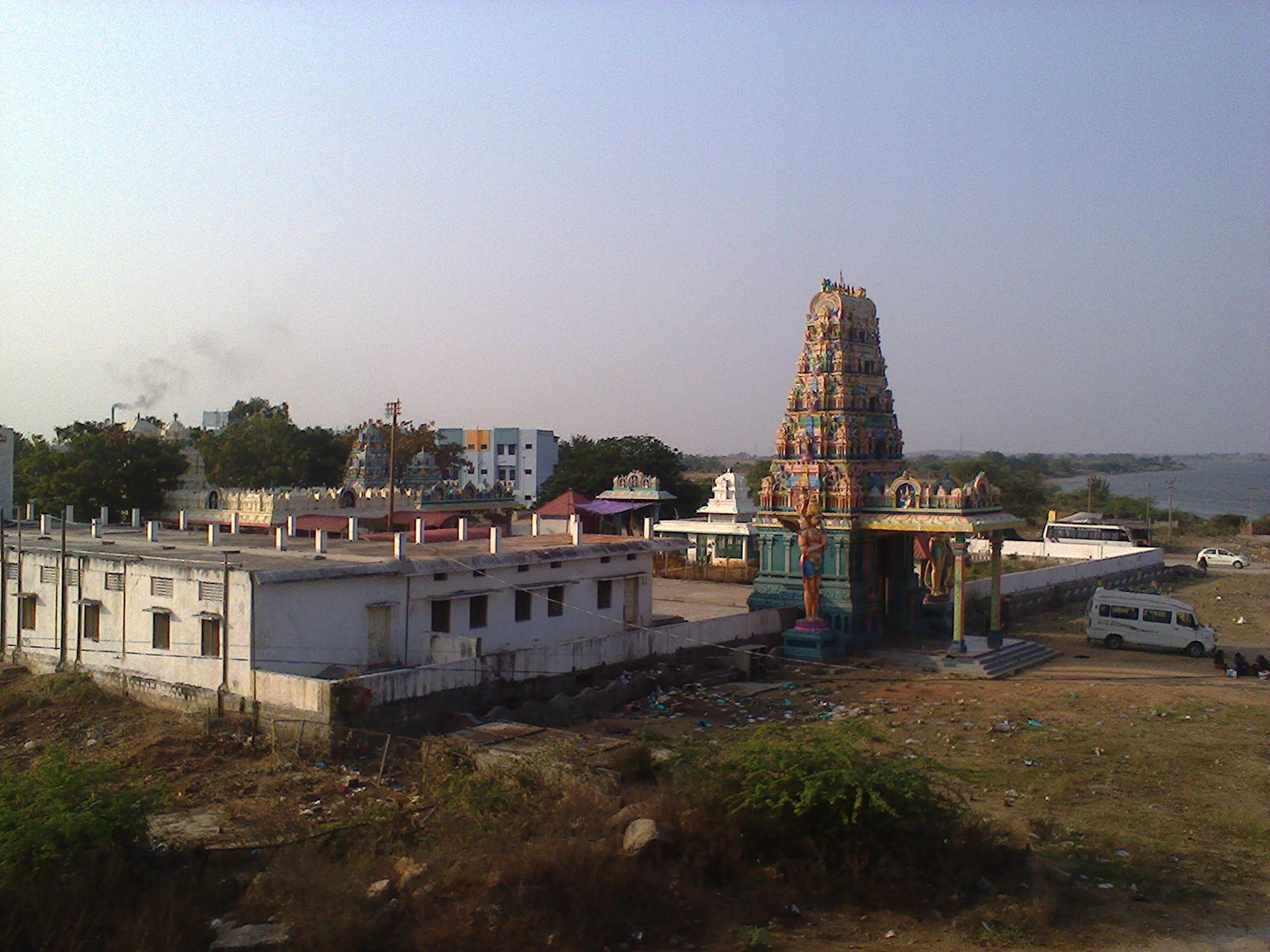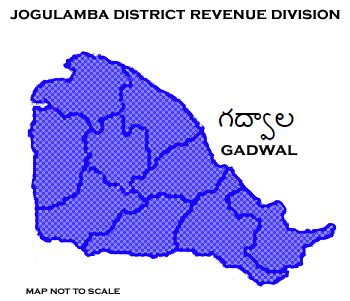|
Beechupally
Beechupally in Jogulamba Gadwal district, Telangana, India, is one of the famous shrines for the god Hanuman (Anjaneya Swamy). It is located on the banks of Krishna River about 30 kilometers downstream from the Jurala Project. The shores of Krishna River at this location are noted for carrying out obsequies to the departed souls as per the Hindu custom. The development of the shrine has been augmented by the passage of national highway NH7 through the village. A road bridge built in the 1950s helped trading between Telangana and Rayalaseema regions of Andhra Pradesh. The bridge was one of the first connections between central/north India and south India. This highway has been renumbered as NH-44 ational Highway 44 (India) Initially, the shrine consisted of a Hanuman temple about 200 meters away from the river and a Shiva lingam temple near the river. During the rainy season, the water flow becomes high enough to touch the Shiva lingam temple. A temple for Lord Rama was a ... [...More Info...] [...Related Items...] OR: [Wikipedia] [Google] [Baidu] |
Jogulamba Gadwal District
Jogulamba district is a district in the Indian state of Telangana. The administrative headquarters of the district is located at Gadwal. The district shares boundaries with Narayanpet, Wanaparthy districts and with the state boundary of Andhra Pradesh and Karnataka. The district was carved out from Mahabubnagar district in 2016. The district is spread over an area of . the 2011 Census of India, the area within the district had a population of 609,990. Administrative divisions The district has one revenue division, Gadwal, and is sub-divided into 12 mandals. Mandals Demographics The district has a population of 6,09,990 of which 3,09,274 are males and 3,00,716 females. Urban population is 63,177 (10.36%). Scheduled Castes and Scheduled Tribes made up 120,639 (19.77%) and 9376 (1.54%) of the population respectively. At the time of the 2011 census, 90.09% of the population spoke Telugu and 7.49% Urdu as their first language. See also * List of districts in Telanga ... [...More Info...] [...Related Items...] OR: [Wikipedia] [Google] [Baidu] |
Telangana
Telangana (; , ) is a States and union territories of India, state in India situated on the south-central stretch of the Indian subcontinent, Indian peninsula on the high Deccan Plateau. It is the List of states and union territories of India by area, eleventh-largest state and the List of states and union territories of India by population, twelfth-most populated state in India with a geographical area of and 35,193,978 residents as per 2011 Census of India, 2011 census. On 2 June 2014, the area was separated from the northwestern part of Andhra Pradesh as the newly formed States and union territories of India, state with Hyderabad as its capital. Its other major cities include Warangal, Nizamabad, Telangana, Nizamabad, Khammam, Karimnagar and Ramagundam. Telangana is bordered by the states of Maharashtra to the north, Chhattisgarh to the northeast, Karnataka to the west, and Andhra Pradesh to the east and south. The terrain of Telangana consists mostly of the Deccan Plateau wi ... [...More Info...] [...Related Items...] OR: [Wikipedia] [Google] [Baidu] |
Hanuman
Hanuman (; sa, हनुमान, ), also called Anjaneya (), is a Hindu god and a divine '' vanara'' companion of the god Rama. Hanuman is one of the central characters of the Hindu epic ''Ramayana''. He is an ardent devotee of Rama and one of the Chiranjivis. Hanuman is regarded to be the son of the wind-god Vayu, who in several stories played a direct role in Hanuman's birth, and considered to be an incarnation or son of Shiva in Shaivism. Hanuman is mentioned in several other texts, such as the epic ''Mahabharata'' and the various Puranas. Evidence of devotional worship to Hanuman is largely absent in these texts, as well as in most archeological sites. According to Philip Lutgendorf, an American Indologist, the theological significance of Hanuman and devotional dedication to him emerged about 1,000 years after the composition of the ''Ramayana'', in the 2nd millennium CE, after the arrival of Islamic rule in the Indian subcontinent.Paula Richman (2010), ''Review: Lut ... [...More Info...] [...Related Items...] OR: [Wikipedia] [Google] [Baidu] |
Hindu
Hindus (; ) are people who religiously adhere to Hinduism.Jeffery D. Long (2007), A Vision for Hinduism, IB Tauris, , pages 35–37 Historically, the term has also been used as a geographical, cultural, and later religious identifier for people living in the Indian subcontinent. The term ''"Hindu"'' traces back to Old Persian which derived these names from the Sanskrit name ''Sindhu'' (सिन्धु ), referring to the river Indus. The Greek cognates of the same terms are "''Indus''" (for the river) and "''India''" (for the land of the river). The term "''Hindu''" also implied a geographic, ethnic or cultural identifier for people living in the Indian subcontinent around or beyond the Sindhu (Indus) River. By the 16th century CE, the term began to refer to residents of the subcontinent who were not Turkic or Muslims. Hindoo is an archaic spelling variant, whose use today is considered derogatory. The historical development of Hindu self-identity within the local In ... [...More Info...] [...Related Items...] OR: [Wikipedia] [Google] [Baidu] |
National Highway 7 (India)
National Highway 7 (NH 7) is a highway connecting Fazilka (Punjab) to Mana (Uttarakhand) in India. It passes through the Indian states of Punjab, Haryana, Himachal Pradesh, and Uttarakhand. The NH-7 (old NH-58) connects Hindu pilgrim centres of Rishikesh, Devprayag, Rudraprayag, Karnaprayag, Chamoli, Joshimath and Badrinath with Dehradun and Chandigarh. Pilgrims travelling to Sri Hemkunt Sahib take a diversion from Govindghat which lies on NH-7 between Joshimath and Badrinath. The road is generally closed during the winter months of December, January, February and March in the upper reaches of the Himalayas through which National Highway 7 passes. This road goes to Mana Pass near the India-Tibetan border. Route The route of national highway 7 transits through the states of Punjab, Haryana, Himachal Pradesh, and Uttarakhand in India. This national highway is about long. Punjab NH7 starts from India-Pakistan Border, connecting Fazilka, Abohar, Malout, Bathinda, Rampu ... [...More Info...] [...Related Items...] OR: [Wikipedia] [Google] [Baidu] |
Rayalaseema
Rayalaseema () is a geographic region in the Indian state of Andhra Pradesh. It comprises eight south western districts of the State namely, Kurnool, Nandyal, Anantapur, Sri Sathya Sai, YSR, Annamayya, Tirupati and Chittoor districts census of India, the region with four districts had a population of 15,184,908 and covers an area of . Etymology The region was previously called ''Ceded districts'' during the rule of the British Raj. This is with reference to the time when the Nizam of Hyderabad, Ali Khan ceded the region to the British as a part of subsidiary alliance. Chilukuri Narayana Rao, a Telugu lecturer and activist from Anantapur deemed the term "ceded" as derogatory and coined the term ''Rayalaseema''. In the Andhra Mahasabha and Ceded Districts Conference held at Nandyala in November 1928, he moved a resolution to the effect which was accepted by the other delegates of the conference. The name ''Rayalaseema'' hearkened back to the Vijayanagara times, whose ... [...More Info...] [...Related Items...] OR: [Wikipedia] [Google] [Baidu] |
Andhra Pradesh
Andhra Pradesh (, abbr. AP) is a state in the south-eastern coastal region of India. It is the seventh-largest state by area covering an area of and tenth-most populous state with 49,386,799 inhabitants. It is bordered by Telangana to the north-west, Chhattisgarh to the north, Odisha to the north-east, Tamil Nadu to the south, Karnataka to the west and the Bay of Bengal to the east. It has the second longest coastline in India after Gujarat, of about . Andhra State was the first state to be formed on a linguistic basis in India on 1 October 1953. On 1 November 1956, Andhra State was merged with the Telugu-speaking areas (ten districts) of the Hyderabad State to form United Andhra Pradesh. ln 2014 these merged areas of Hyderabad State are bifurcated from United Andhra Pradesh to form new state Telangana . Present form of Andhra similar to Andhra state.but some mandalas like Bhadrachalam still with Telangana. Visakhapatnam, Guntur, Kurnool is People Capital of And ... [...More Info...] [...Related Items...] OR: [Wikipedia] [Google] [Baidu] |
NH-44
National Highway 8 (NH 8) is a National Highway in India running from Karimganj in Assam to Sabroom in Tripura. It is not to be confused with former NH 8 (Delhi-Jaipur-Baroda-Bombay), which has been renumbered NH 48 National Highway 48 (NH 48) is a National Highway of India that starts at Delhi and terminates at Chennai traversing through seven states of India. It has a total length of 2807 km (1744 miles). NH 48 passes through the states of Del .... References External links NH 8 on OpenStreetMap {{IND NH8 sr National highways in India ... [...More Info...] [...Related Items...] OR: [Wikipedia] [Google] [Baidu] |
Shiva Lingam
A lingam ( sa, लिङ्ग , lit. "sign, symbol or mark"), sometimes referred to as linga or Shiva linga, is an abstract or aniconic representation of the Hindu god Shiva in Shaivism. It is typically the primary ''murti'' or devotional image in Hindu temples dedicated to Shiva, also found in smaller shrines, or as self-manifested natural objects. It is often represented within a disc-shaped platform, the ''yoni'' – its feminine counterpart, consisting of a flat element, horizontal compared to the vertical lingam, and designed to allow liquid offerings to drain away for collection. Together, they symbolize the merging of microcosmos and macrocosmos, the divine eternal process of creation and regeneration, and the union of the feminine and the masculine that recreates all of existence. The original meaning of ''lingam'' as "sign" is used in Shvetashvatara Upanishad, which says "Shiva, the Supreme Lord, has no liūga", liuga ( sa, लिऊग ) meaning he is transcen ... [...More Info...] [...Related Items...] OR: [Wikipedia] [Google] [Baidu] |
Lord Rama
Rama (; ), Ram, Raman or Ramar, also known as Ramachandra (; , ), is a major deity in Hinduism. He is the seventh and one of the most popular ''avatars'' of Vishnu. In Rama-centric traditions of Hinduism, he is considered the Supreme Being. Rama is said to have been born to Kaushalya and Dasharatha in Ayodhya, the ruler of the Kingdom of Kosala. His siblings included Lakshmana, Bharata (Ramayana), Bharata, and Shatrughna. He married Sita. Though born in a royal family, their life is described in the Hindu texts as one challenged by unexpected changes such as an exile into impoverished and difficult circumstances, ethical questions and moral dilemmas. Of all their travails, the most notable is the kidnapping of Sita by demon-king Ravana, followed by the determined and epic efforts of Rama and Lakshmana to gain her freedom and destroy the evil Ravana against great odds. The entire life story of Rama, Sita and their companions allegorically discusses duties, rights and social ... [...More Info...] [...Related Items...] OR: [Wikipedia] [Google] [Baidu] |




.jpg)
.jpg)



